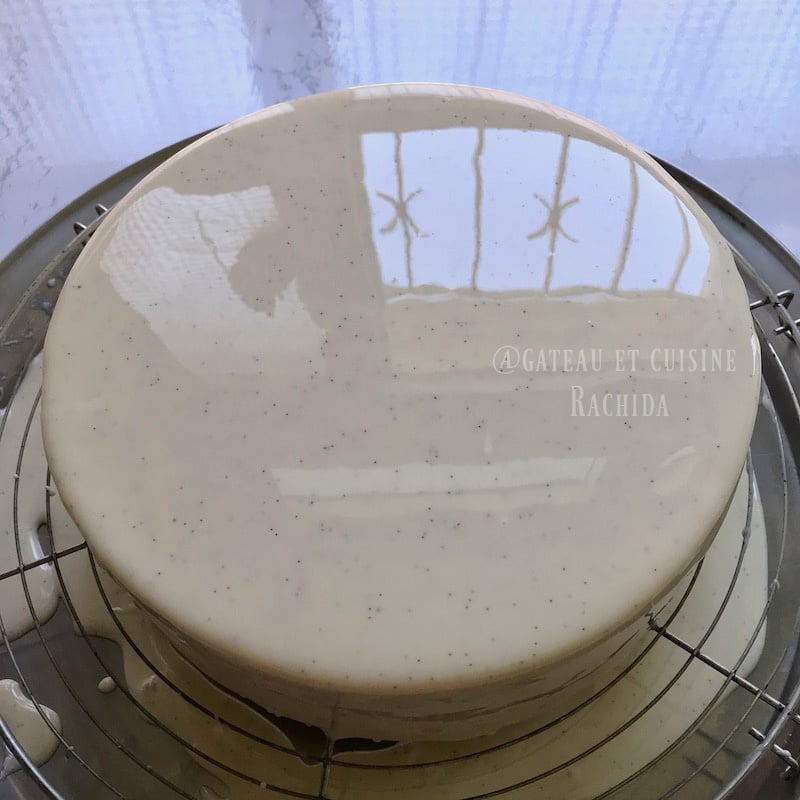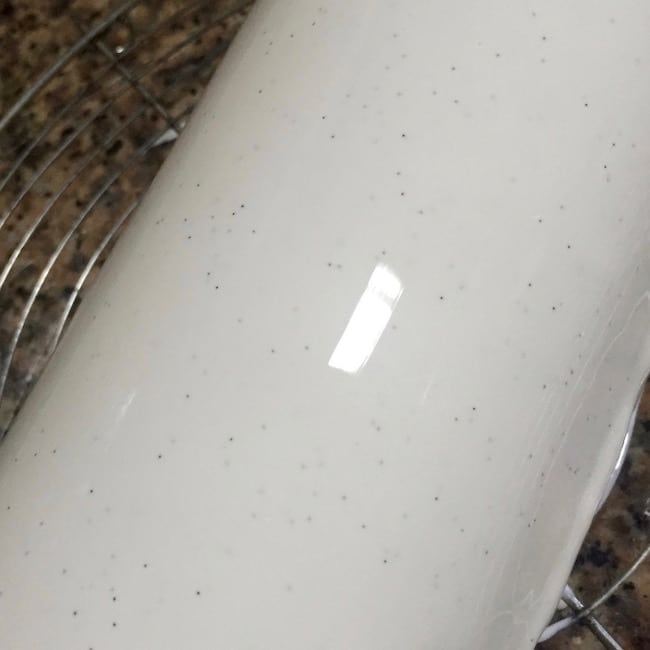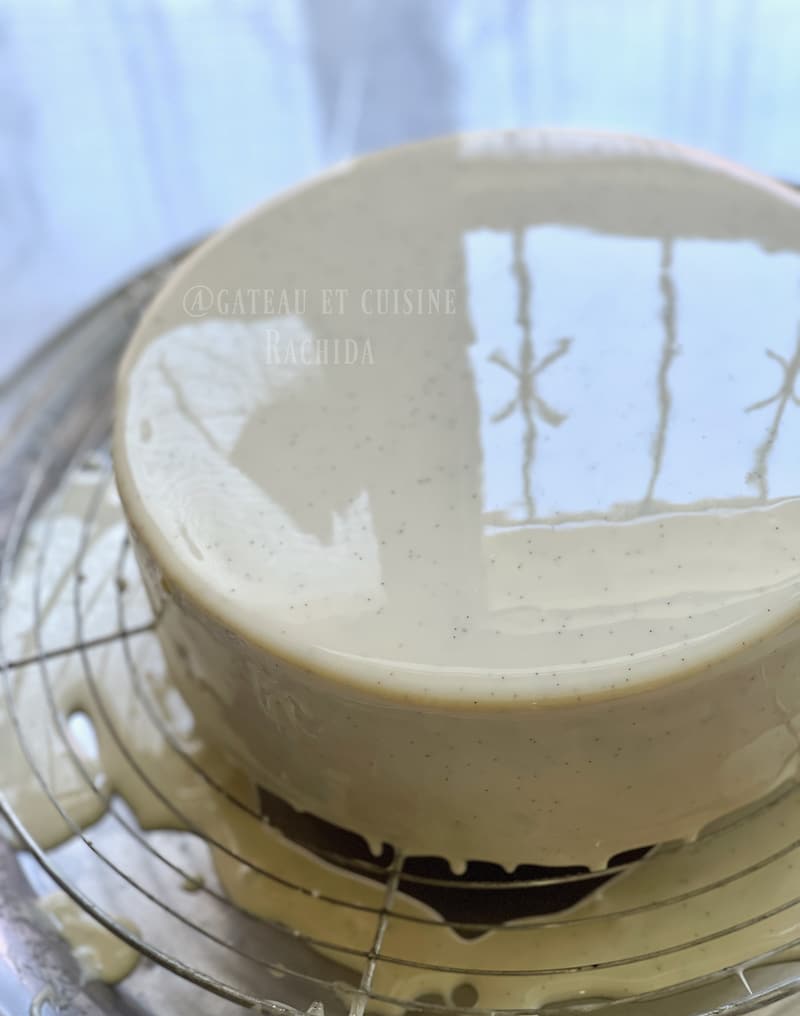The white mirror glaze is ideal for covering mousse cake ( french entremets ) and yule logs with light mousses so that nothing shows through underneath. Prepared with white chocolate, glucose, and cream, it makes desserts shine by giving them a refined touch with a beautiful effect.

Easy White Mirror Glaze
I love mirror glaze because it gives a beautiful, elegant finish to entremets. I have several recipes that will all be useful for enhancing your pastries. There’s the ultra-shiny chocolate mirror glaze, which you can make with white, dark, or milk chocolate, guaranteeing a stunning mirror effect.
I also shared a version without glucose or condensed milk, which is excellent as well. I’ll add the links to the recipes below.
Many of you have asked me how to achieve a white mirror glaze. I wrote this article so that everyone can find the answer.
This glaze is the same as the chocolate mirror glaze mentioned above, except that this one is a white chocolate mirror glaze, to which I add vanilla seeds, although this is optional.

white chocolate glaze
Table of Contents
How to make a flawless white mirror glaze?
To achieve that perfect white and also to get an opaque mirror glaze, it’s recommended to add a little titanium dioxide. However, in recent years, this ingredient, which is actually a food additive “E171”, has been criticized for its harmful effects on health.
It has been highly controversial. I’m not sure at what dosage it becomes harmful. When I made this glaze, which was some time ago, it wasn’t a topic of discussion. I tried to find a white food coloring, but the ones I came across, despite the “natural” label they carry, still contain E171.
We can simply do without it while waiting for more clarity on the matter. The glaze will still be shiny, but less white. It will depend on the chocolate used.
I recommend using Valrhona’s Ivoire or Opalys chocolate, or Cacao Barry’s Zéphyr.
This white glaze should be poured over entremets with light-colored mousse bases, like this vanilla mousse log, for good coverage.

Ingredients:
Preferably prepare the day before glazing the mousse cake.
This recipe makes enough for a 20/22 cm (8/9-inch) round mold. For a 30 cm / 12-inch log, multiply the recipe by 1.5
- 75 g water
- 150 g granulated sugar
- 150 g glucose
- 150 g white chocolate (Ivoire by Valrhona, which is very white)
- 100 g sweetened condensed milk (or preferably 30% heavy cream to enhance the white color)
- 10 g powdered gelatin (200 blooms) or 5 sheets of 2 g. I sometimes use sheets with 150 blooms (3.4 g), also known as bronze, and it works great. (Edit 2024: Now, I only use 9 g of gelatin or 4 and a half sheets, and the result is excellent)
- 60 g water if using powdered gelatin for rehydration
- White food coloring (2 g, or as needed, I no longer use it-see above)
- 1 plump vanilla bean (or 1 and a half) (use the seeds) (optional)
Important note:
You can substitute the sweetened condensed milk in some of my glazing recipes with 30% cream. The result is the same. For this white glaze, I recommend using heavy cream to enhance the white color.
Preparation steps:
Rehydrate the powdered gelatin with 60 g (2.1 oz) of water or soak the gelatin sheets in a large volume of water, 10 to 15 minutes before starting. For powdered gelatin, rehydrate it in 6 times its weight in water for at least 20 minutes, then set it aside in the refrigerator.
Place the glucose, sugar, vanilla seeds, and water in a saucepan. Bring to a boil and cook until it reaches 103°C (217°F). Stir occasionally, making sure not to splash the sides. If any splashes occur, clean the sides with a damp brush.
Pour the mixture through a fine sieve over the condensed milk (or liquid cream), then add the gelatin.
Gently stir with a spatula, then pour over the white chocolate and food coloring in a tall, narrow container (like a measuring jug or a container suited for an immersion blender). Wait a minute, then stir again with the spatula.
Emulsify carefully with an immersion blender. This step must be done cautiously to avoid introducing air bubbles.
Blend while keeping the container slightly tilted and the blender immersed at an angle, ensuring it remains submerged throughout. Only remove the blender once the mixing is complete.
Pour the mixture through a fine sieve into an airtight container and cover it with plastic wrap directly on the surface. Refrigerate.
The next day, reheat in a saucepan over a double boiler or in the microwave until it reaches 38-40°C (100-104°F).

Occasionally remove from the double boiler, stir, and then return to the double boiler or microwave. Repeat this process several times to ensure the temperature does not exceed the desired level and to fully melt the mixture.
Pour into a tall, narrow container. Carefully blend with an immersion blender for 3 to 4 minutes to eliminate any air bubbles.
Allow the temperature to cool to 33-34°C (91-93°F), or slightly more or less depending on its viscosity, then glaze the frozen entremet straight from the freezer.

Other glaze recipes you might like:
Chocolate and cocoa glaze recipe
Glaze without glucose or condensed milk

White Chocolate Mirror Glaze
INGREDIENTS
Preferably prepare the day before glazing the mousse cake.
- This recipe makes enough for a 20/22 cm (8/9-inch) round mold. For a 30 cm / 12-inch log, multiply the recipe by 1.5
- 75 g water
- 150 g granulated sugar
- 150 g glucose
- 150 g white chocolate Ivoire by Valrhona, which is very white
- 100 g sweetened condensed milk or preferably 30% heavy cream to enhance the white color
- 10 g powdered gelatin 200 blooms or 5 sheets of 2 g. I sometimes use sheets with 150 blooms (3.4 g), also known as bronze, and it works great. (Edit 2024: Now, I only use 9 g of gelatin or 4 and a half sheets, and the result is excellent)
- 60 g water if using powdered gelatin for rehydration
- White food coloring 2 g, or as needed, I no longer use it-see above
- 1 plump vanilla bean or 1 and a half (use the seeds) (optional)
PREPARATION
- Rehydrate the powdered gelatin with 60 g of water or soak the gelatin sheets in a large volume of water, 10 to 15 minutes before starting. For powdered gelatin, rehydrate it in 6 times its weight in water for at least 20 minutes, then set it aside in the refrigerator.
- Place the glucose, sugar, vanilla seeds, and water in a saucepan. Bring to a boil and cook until it reaches 103°C (217°F). Stir occasionally, making sure not to splash the sides. If any splashes occur, clean the sides with a damp brush.
- Pour the mixture through a fine sieve over the condensed milk (or liquid cream), then add the gelatin.
- Gently stir with a spatula, then pour over the white chocolate and food coloring in a tall, narrow container (like a measuring jug or a container suited for an immersion blender). Wait a minute, then stir again with the spatula.
- Emulsify carefully with an immersion blender. This step must be done cautiously to avoid introducing air bubbles.
- Blend while keeping the container slightly tilted and the blender immersed at an angle, ensuring it remains submerged throughout. Only remove the blender once the mixing is complete.
- Pour the mixture through a fine sieve into an airtight container and cover it with plastic wrap directly on the surface. Refrigerate.
- The next day, reheat in a saucepan over a double boiler or in the microwave until it reaches 38-40°C (100-104°F).
- Occasionally remove from the double boiler, stir, and then return to the double boiler or microwave. Repeat this process several times to ensure the temperature does not exceed the desired level and to fully melt the mixture.
- Pour into a tall, narrow container. Carefully blend with an immersion blender for 3 to 4 minutes to eliminate any air bubbles.
- Allow the temperature to cool to 33-34°C (91-93°F), or slightly more or less depending on its viscosity, then glaze the frozen entremet straight from the freezer.
Thank you for your visit and your comments!
